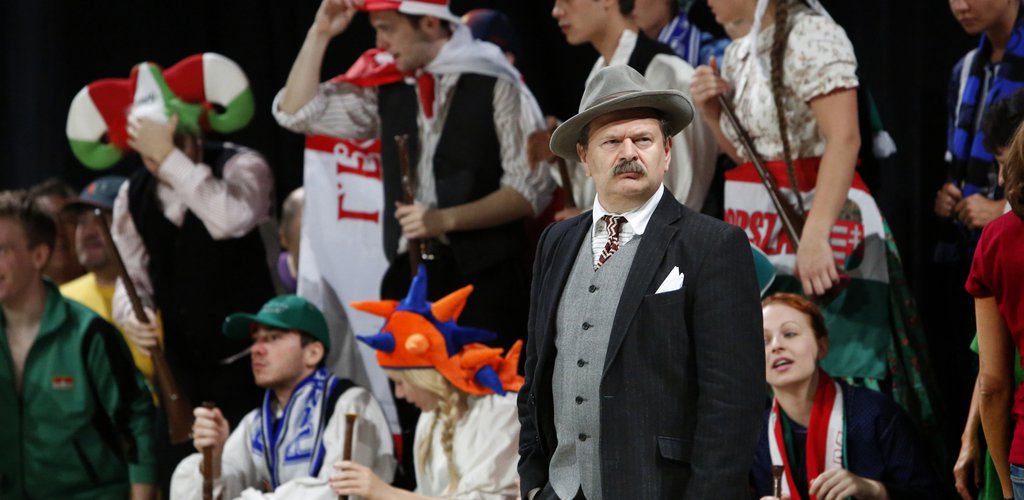Cast:
Gyula Krúdy: József Gyabronka
Móric: Jonatán Kovács
Eszter: Kyra Varga
Kálmán: Zsombor Jéger
Cow: György Kozma
A Man: János Tóth
The Red Heifer (Innkeeper): Orsolya Sáfár
Richter (Tenor): József Csapó
József Scharf: Tamás Altorjay
Buxbaum: Sebestyén László Szabó
Lajos Kossuth (Bass): Krisztián Cser
Acting Students from University of Theater and Film Arts Budapest
Production:
Director: Györgi Szakács
Sets: Bertalan Vári
Choreography: Eszter Balassa
Costumes: Nóra Patrícia Kovács
Iván Fischer’s musical theater piece, Die Rote Färse (The Red Heifer), combines contemporary and traditional musical genres in a postmodern pastiche rife with relevance. The four-show run at Berlin’s Konzerthaus marks the first time the work has been performed outside of Hungary, a meaningful event for Fischer, who is chief conductor of Berlin’s Konzerthaus Orchestra and musical director of the Budapest Festival Orchestra. The ensemble was comprised of members from both groups.
Brushing aside operatic formality, Fischer gave an animated pre-concert talk on the history of the story, characters and composition. “This is Reflexionstheater,” he commented during his address. “Sometimes the music will slow down, giving the audience time to think and reflect. You must think!”
The libretto is drawn from a 1931 novel by Hungarian writer Gyulia Krúdy (A tiszaeszlári Solymosi Eszter), which is based on the Tiszaeszlár blood libel of 1882. In this monumental case, several Jews in a small Hungarian village were accused of slaughtering a missing 14-year-old Christian girl in an act of religious fanaticism. They were acquitted after a long trial, but the event prompted a wave of anti-Semitism that, sadly, is present in Hungary today. Such sentiments appear in the rhetoric of nationalist political movements such as the Jobbik party, currently the third largest in the country’s national assembly. In 2012, party representative Zsolt Baráth even asked the government to reopen the 1882 Tiszaeszlár case. Fischer, who is Jewish, addresses his country’s rising conservatism, stating in the program that the rhetoric, stereotypes and irrational prejudices found in The Red Heifer are still prevalent.
The trial drew largely on the story told by 14-year-old Móric Scharf, who testified against his father and described the gruesome slaughter in detail. In four lightly connected scenes, the work focuses on the boy as he recalls the events leading up to the trial. Much of the 50-minute performance is fast-paced, almost schizophrenic. “Sometimes you will hear a bit of Bach, Beethoven or Kurt Weill mixed in with traditional Hungarian and Jewish folk music,” Fischer told the audience in the pre-performance address. He has cleverly parodied the genres, juxtaposing them in a way that allows us to experience the music through Móric’s memory.
Set in the late 19th century, the opera opens with a group of townspeople in traditional dress, dancing to Hungarian folk melodies in the Red Heifer Inn. Móric, the lone Jewish boy, seems to be entranced by it all, and the music reflects his joy. During the trial scene, Móric, egged on by a host of his countrymen, spits out his testimony in a breathless rap-like ferocity to drum-heavy accompaniment. As if cheering on Hungary in the World Cup, the ensemble is dressed in a combination of traditional clothing and contemporary soccer paraphernalia emblazoned with the national team’s logo. Some of them blow vuvuzelas while Móric steps up to the bench and delivers his gory testimony. Here we catch a glimpse of the longing for acceptance that may have led him astray.
Suddenly, the harsh accompaniment is replaced by a Klezmer-reminiscent melody as his father reminds him that not even a chicken would be killed for the Seder. The music reflects the boy’s uncertainty, yet he refuses to back down.
Just as Fischer blends musical styles, so does he intermingle a small cast of dancers, actors and opera singers in an amalgamation that shuns tradition. This interplay is important for Fischer who prefers the piece not be referred to as an opera. He cites instead the theater of Brecht and Weill as his preferred approach to performance. Their use of simple melodies, he claims, brings the story into direct contact with the music.
The Jewish innkeeper, also referred to as “the red heifer,” is crudely sexualized. She sings of the stereotypes of her religion unabashedly while men shower her with attention. The part was played by Orsolya Sáfár, a soprano with a robust voice that showed full flexibility during “Hey Jewish girl,” a melodic, folksong-like piece borrowed from a well-known song included in Krúdy’s novel. The author also appears in the piece as narrator, a role suitably acted by Jószsef Gyabronka. This part, as well as those of the judge (Jószsef Csapó) and Jószsef Scharf (Tamás Altorjay), fit into Fischer’s interplay between theater and opera. These particular roles, as Fischer pointed out in the program, should be performed by “singers who can act or actors who can sing.” It’s a fitting comment, since such vocal parts require a touch of Weimar-era cabaret style. The mixture of operatic and non-classical voices and the ever-changing instrumental terrain kept the performance interesting throughout. For instance, Krúdy spoke-sang over several bars that could have been taken directly from the recitative of a Bach oratorio.
In the final scene, father and son pray together in silence; the music stretches and slows. It’s time for the audience to think about what they’ve heard, just as Fischer asked. One hopes that his powerful message will continue to resonate as the work spreads to audiences worldwide.


